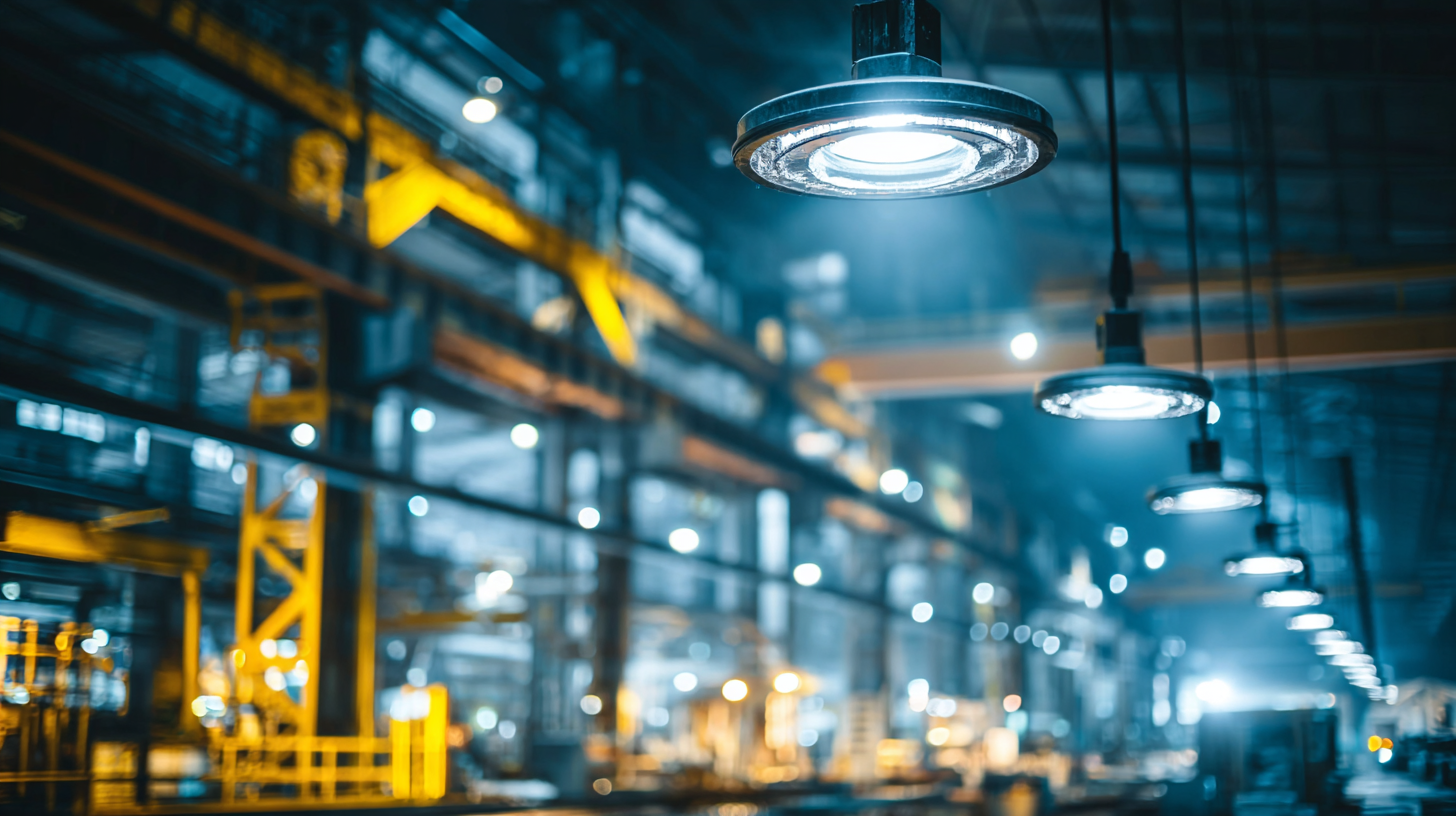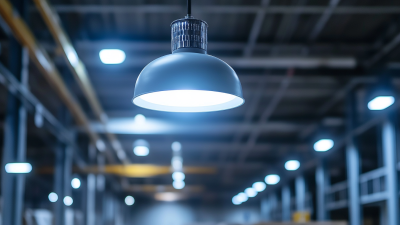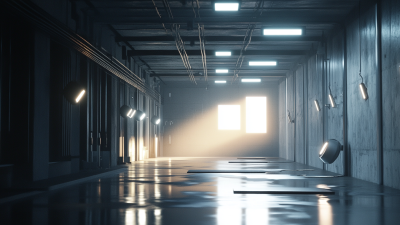Revolutionizing Industrial Lighting: How LED Technology is Enhancing Energy Efficiency by 75% in Factories
As industries increasingly seek innovative solutions to boost efficiency and reduce operational costs, the role of Industrial Lighting has come to the forefront. Recent studies indicate that LED technology can enhance energy efficiency in factories by up to 75%, translating into significant savings on energy bills and a lower carbon footprint. According to a report by the International Energy Agency, industrial lighting accounts for approximately 15% of total global electricity consumption, highlighting the potential for impactful change.

The transition from traditional lighting to LED systems not only increases productivity through improved visibility but also aligns with sustainability goals, as LED solutions often have longer lifespans and less environmental impact. Embracing these advancements in Industrial Lighting is not just a trend but a strategic move towards a more efficient and sustainable future for manufacturing facilities.
The Impact of LED Technology on Industrial Lighting Efficiency
The advancements in LED technology continue to revolutionize industrial lighting, significantly enhancing energy efficiency across various applications. Reports indicate that LED lighting can improve energy efficiency by up to 75%, making it the preferred choice for factories seeking to reduce operational costs while maintaining optimal lighting conditions. Notably, the global LED lighting market is projected to grow significantly, with estimates revealing that it will climb from $4.07872 billion in 2025 to $22.3818 million by 2033, reflecting a compound annual growth rate (CAGR) of 7.79%. Such growth underscores the demand for energy-efficient solutions in diverse sectors including residential, industrial, and retail.
The market for energy-efficient lighting technologies, particularly in industrial settings, reveals compelling statistics. By 2033, the market for these technologies is expected to see a substantial decline of over $4 billion, showcasing the competitive landscape and the shift towards innovative lighting solutions. Additionally, outdoor applications, such as street lighting, are increasingly leveraging LED technology to enhance visibility and safety while minimizing energy consumption. As this trend continues, manufacturers and retailers are focusing on direct sales and e-commerce channels to reach a broader audience, facilitating easier access to these cutting-edge products. This transition not only benefits manufacturers and consumers but also plays a vital role in fostering sustainable industrial practices globally.
Key Benefits of Switching to LED Solutions in Factories
LED technology is reshaping industrial lighting, providing significant enhancements in energy efficiency that can reach up to 75%. This transition is crucial for factories striving to meet the dual demands of high-quality production and cost-effectiveness. By utilizing LED solutions, factories can significantly reduce their energy consumption, thereby lowering operational costs while also contributing to a more sustainable environment. According to industry reports, replacing traditional lighting with LED systems can lead to a decrease in energy expenses by around 50-80%, depending on the specific application and usage patterns.
Moreover, the benefits of switching to LED lighting extend beyond energy savings. LEDs have a longer lifespan compared to conventional lighting options, requiring fewer replacements and reducing maintenance efforts. This longevity translates into less downtime for factories, allowing for increased productivity. Furthermore, advancements in smart lighting technologies, including controls and automation, are integrating seamlessly into the digital transformation efforts observed in many sectors. For instance, with the rise of intelligent manufacturing solutions, the use of smart LED lighting can be efficiently managed, further optimizing energy use and enhancing overall factory operations.
Revolutionizing Industrial Lighting: LED Technology and Its Impact on Energy Efficiency
| Factory Type | Energy Consumption (kWh) | Cost Savings ($/year) | Reduction in Carbon Footprint (tons/year) | Payback Period (months) |
|---|---|---|---|---|
| Automotive Manufacturing | 150,000 | $20,000 | 100 | 18 |
| Textile Manufacturing | 200,000 | $30,000 | 150 | 16 |
| Food Processing | 120,000 | $15,000 | 80 | 20 |
| Electronics Assembly | 110,000 | $12,000 | 75 | 22 |
| Plastic Manufacturing | 180,000 | $25,000 | 120 | 19 |
Comparative Analysis: Traditional vs. LED Lighting in Industrial Settings
In the evolving landscape of industrial lighting, the transition from traditional solutions to LED technology marks a significant transformation. Compared to conventional lighting, which often relies on less efficient bulbs that consume more energy, LED lighting excels with its superior energy efficiency and longevity. In fact, studies have shown that LED technology can enhance energy efficiency by up to 75% in factory settings, drastically reducing operational costs and environmental impact.
Tips: When considering an upgrade to LED lighting, assess your facility's specific needs for brightness and coverage. This ensures that you choose the right type of LED fixtures to maximize efficiency. Additionally, explore smart lighting controls that can further optimize energy use based on real-time needs, enhancing savings.
The global market for high bay LED lighting is projected to grow significantly, reaching a value of $3.52 billion in 2024 and a remarkable $6.18 billion by 2033. This growth underscores the mounting preference for LED systems in industrial environments, driven by their cost-effectiveness and sustainability. As more factories adopt LED technology, the shift promises not just economic benefits but also a move towards greener manufacturing practices.
Tips: Conducting a cost-benefit analysis before making the switch can help identify potential savings and payback periods. Consider potential rebates or incentives available for upgrading to energy-efficient lighting, which can further reduce initial investment costs.

Innovative Applications of LED Lighting in Factory Environments
In recent years, LED technology has emerged as a game-changer in industrial lighting, particularly within factory environments. The application of LED lights in production facilities has proven to enhance energy efficiency by an impressive 75%, as reported by the U.S. Department of Energy. These significant reductions in energy consumption not only lower operational costs but also contribute to a more sustainable manufacturing ecosystem. Factories that have adopted LED lighting solutions report reduced heat output, leading to lower cooling costs and improved worker comfort, which boosts overall productivity.
Moreover, innovative applications of LED technology extend beyond traditional lighting. For instance, smart LED systems can be integrated with IoT devices to optimize lighting based on real-time occupancy and natural light availability. According to a report from the Lighting Research Center, implementing such responsive lighting systems can further amplify energy savings by around 30%. Additionally, LED lights offer longer lifespans—often exceeding 50,000 hours—compared to traditional incandescent or fluorescent bulbs, significantly minimizing maintenance costs for industrial operators. By embracing these advancements, factories can not only achieve remarkable energy efficiency but also foster a more intelligent and adaptable work environment.
Future Trends: Advancements in LED Technology for Industrial Use
The advancements in LED technology are driving a transformative change in industrial lighting, making it possible to achieve higher energy efficiency and lower operational costs. Recent developments have focused on integrating smart sensors and data analytics into LED systems, allowing factories to optimize their lighting based on real-time conditions. For instance, sensors can adjust light intensity according to the presence of workers, natural light levels, or specific tasks being performed, thereby minimizing wasted energy.
Moreover, the evolution of LED materials and designs has led to more durable and versatile lighting solutions suitable for various industrial applications. New innovations, such as tunable white LEDs, enable factories to customize the lighting spectrum, promoting better visibility and worker productivity. As LED technology continues to evolve, we can anticipate further enhancements in energy efficiency and sustainability, pushing industries closer to their environmental goals while also improving overall operational efficiency.

Related Posts
-

Future Innovations in Industrial Lighting and Their Advantages for Global Buyers
-

Navigating Global Standards for Industrial Lighting Certification and Compliance
-

Unlocking Energy Efficiency in Manufacturing with Industrial Led Fixtures and Industry Insights
-

Advantages of Optimal Industrial Lighting for Enhanced Productivity
-

How to Enhance Your Outdoor Space with Exterior Led Lighting Solutions
-

Unlocking Energy Efficiency with Innovative Commercial Led Fixtures for Global Buyers






